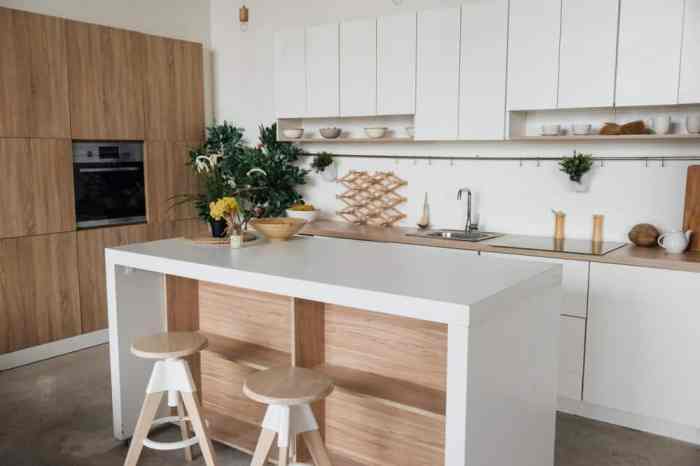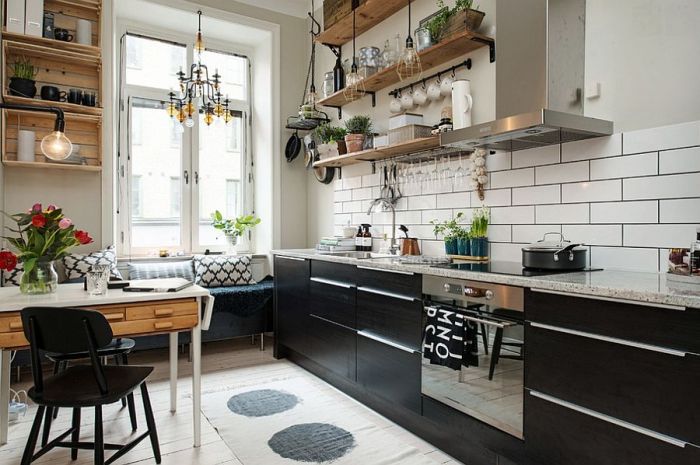Incorporating Scandinavian Design in Your Modular Kitchen offers a unique opportunity to create a space that is both stylish and practical. Scandinavian design principles emphasize simplicity, functionality, and the use of natural materials, resulting in kitchens that are both visually appealing and highly efficient.
In this guide, we will explore the key elements of Scandinavian design and provide practical tips on how to incorporate them into your modular kitchen. From choosing the right materials and color palette to maximizing natural light and incorporating clever storage solutions, we will cover everything you need to know to create a Scandinavian-inspired kitchen that is both beautiful and functional.
Scandinavian Design Principles

Scandinavian design is a style of design that originated in the Nordic countries in the early 20th century. It is characterized by its simplicity, functionality, and use of natural materials. Scandinavian design principles can be easily incorporated into a modular kitchen to create a space that is both stylish and practical.
Simplicity
Simplicity is one of the key characteristics of Scandinavian design. Scandinavian designers believe that less is more, and they strive to create designs that are clean, uncluttered, and easy to understand. In a modular kitchen, simplicity can be achieved by using simple lines, shapes, and colors.
Avoid using too many different materials or finishes, and keep the overall design as streamlined as possible.
Functionality
Functionality is another important principle of Scandinavian design. Scandinavian designers believe that furniture and other objects should be both beautiful and functional. In a modular kitchen, functionality can be achieved by choosing pieces that are well-made and durable. Look for pieces that have multiple uses, and make sure that the layout of the kitchen is efficient and easy to work in.
Natural Materials
Scandinavian designers love to use natural materials, such as wood, stone, and metal. These materials add warmth and character to a space, and they can also help to create a more sustainable kitchen. When choosing materials for your modular kitchen, look for pieces that are made from sustainable materials and that are easy to clean and maintain.
Material Selection
Scandinavian design emphasizes the use of natural materials that create a sense of warmth and coziness. These materials are not only aesthetically pleasing but also durable and long-lasting.
Wood is a key material in Scandinavian design, and it is often used for kitchen cabinets, countertops, and flooring. Wood adds a touch of warmth and texture to the space, and it can be stained or painted to match any décor.
Stone is another popular material for Scandinavian kitchens, and it is often used for countertops and backsplashes. Stone is durable and easy to clean, and it can add a touch of elegance to the space.
Metal, Incorporating Scandinavian Design in Your Modular Kitchen
Metal is also a common material in Scandinavian design, and it is often used for hardware, appliances, and lighting. Metal adds a touch of shine and sophistication to the space, and it can be mixed and matched with other materials to create a unique look.
When choosing materials for your Scandinavian kitchen, it is important to keep in mind the overall design aesthetic you are trying to achieve. Natural materials are a good choice for creating a warm and inviting space, while metal and stone can add a touch of elegance and sophistication.
Color Palette

Scandinavian design embraces a neutral color palette with pops of color. Neutrals like white, beige, and gray create a clean and airy base, while accent colors add vibrancy and personality. This combination evokes a sense of tranquility and balance.
In a modular kitchen, incorporate neutrals for cabinetry, countertops, and backsplash. Add pops of color through accent pieces such as bar stools, pendant lights, or artwork. Consider shades of blue, green, or yellow to bring nature indoors and create a calming atmosphere.
Lighting
Lighting plays a crucial role in Scandinavian design, as it can enhance the sense of space and create a warm and inviting atmosphere. Natural light is highly valued, so maximizing its use is essential.
To maximize natural light, consider installing large windows or skylights that allow ample sunlight to enter the kitchen. Choose light-colored curtains or blinds to filter the light without blocking it completely.
Artificial Lighting
Artificial lighting is also important in Scandinavian design, as it can create a cozy and inviting atmosphere during the darker hours. Use warm, diffused lighting to create a welcoming ambiance. Consider using dimmers to adjust the light intensity and create different moods.
Functionality and Storage
In Scandinavian design, functionality and storage are paramount. Modular kitchens embrace this principle by offering clever storage solutions that maximize space utilization and enhance the overall efficiency of the kitchen.
To incorporate functionality and storage in your modular kitchen, consider the following ideas:
Maximizing Vertical Space
- Utilize tall cabinets and pantry units to store bulky items and less frequently used appliances.
- Install shelves and drawers within cabinets to create additional storage compartments.
Utilizing Corner Spaces
- Incorporate corner cabinets with revolving shelves or pull-out drawers to optimize the use of often-neglected corner spaces.
- Install lazy Susans or corner drawers to make accessing items easier.
Concealing Appliances
- Use built-in appliances, such as ovens and dishwashers, to create a seamless and streamlined look.
- Consider appliance garages or lift-up doors to hide small appliances when not in use.
Closing Notes
By following these principles, you can create a Scandinavian-inspired modular kitchen that is both stylish and practical. With its emphasis on simplicity, functionality, and natural materials, Scandinavian design is a perfect fit for modern kitchens. So if you are looking for a way to create a kitchen that is both beautiful and efficient, consider incorporating Scandinavian design elements into your next renovation.
Popular Questions: Incorporating Scandinavian Design In Your Modular Kitchen
What are the key characteristics of Scandinavian design?
The key characteristics of Scandinavian design include simplicity, functionality, and the use of natural materials.
How can I incorporate Scandinavian design into my modular kitchen?
There are many ways to incorporate Scandinavian design into your modular kitchen. Some tips include using natural materials such as wood and stone, choosing a neutral color palette with pops of color, and maximizing natural light.
What are some tips for choosing materials for a Scandinavian-inspired kitchen?
When choosing materials for a Scandinavian-inspired kitchen, look for natural materials such as wood, stone, and metal. These materials will help to create a warm and inviting space.
